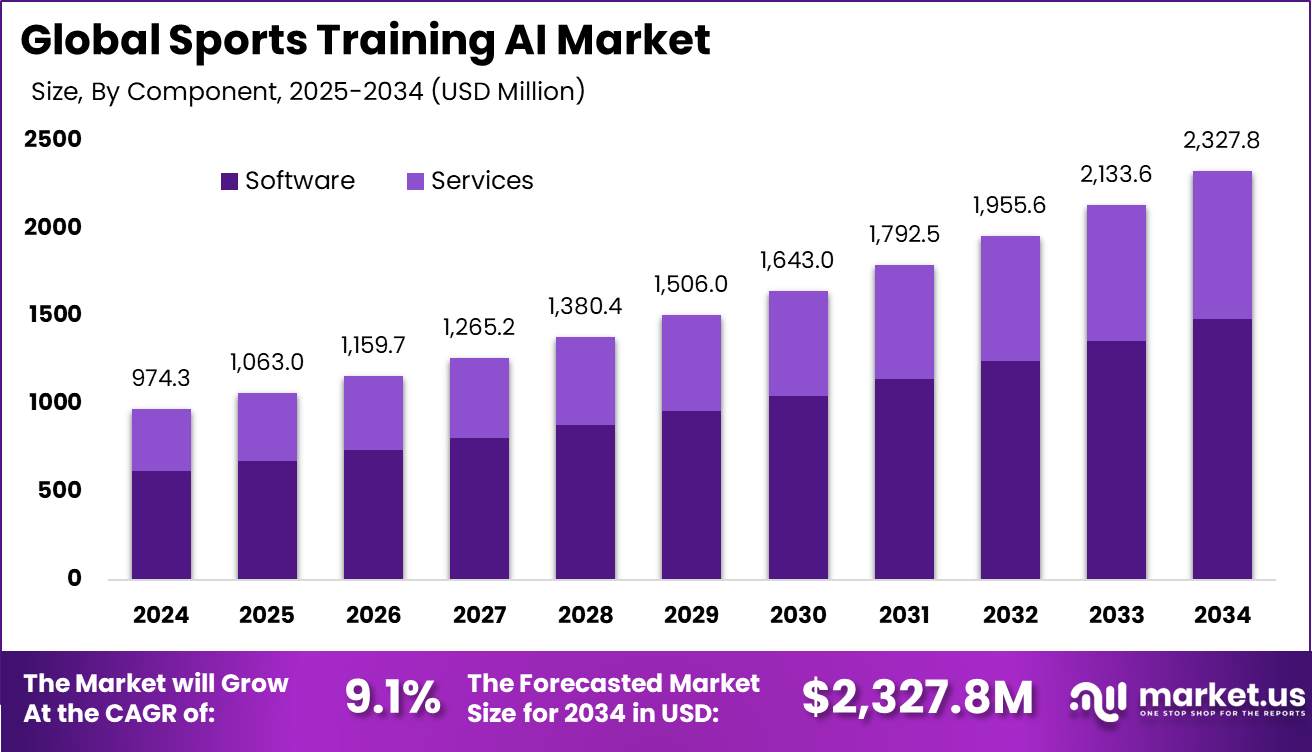Table of Contents
Introduction
The Global Sports Training AI Market is expected to reach USD 2,327.8 million by 2034, rising from USD 974.3 million in 2024 at a CAGR of 9.1%. Demand is expanding as athletes, teams, and fitness consumers adopt AI-driven performance analytics, biomechanical tracking, and personalized coaching. North America dominates the market with a 45.6% share worth USD 444.2 million in 2024, supported by strong tech adoption and advanced sports ecosystems.

How Growth is Impacting the Economy
The rapid expansion of sports training AI is creating new revenue streams across analytics software, wearables, SaaS tools, cloud platforms, and sports science technologies. This growth strengthens the digital economy by attracting investments in AI R&D, data processing infrastructure, and sensor innovation. Job creation is rising across data science, biomechanics, and AI engineering as sports organizations shift toward tech-enabled training models.
Consumer spending on performance optimization is also increasing, boosting hardware demand and subscription-based training platforms. The technology contributes to long-term economic productivity by reducing injury risks, improving athlete performance outcomes, and supporting innovation in health, fitness, and rehabilitation industries.
➤ Smarter strategy starts here! Get the sample – https://market.us/report/sports-training-ai-market/free-sample/
Impact on Global Businesses
Rising Costs & Supply Chain Shifts
Businesses face higher development costs due to continuous algorithm upgrades, sensor advancements, and cloud storage requirements. Supply chains are shifting toward more integrated microchip, IoT, and wearable manufacturing clusters, increasing the need for diversified supplier networks to avoid electronic component shortages.
Sector-Specific Impacts
Sports equipment firms are adding embedded AI sensors. Fitness centers are adopting AI-powered coaching systems. Broadcasting and media companies use AI performance data to enrich viewer experiences. Rehabilitation clinics integrate AI for movement correction and post-injury monitoring, enhancing patient outcomes.
Strategies for Businesses
Companies are focusing on AI-first product design, expanding subscription models, improving data privacy frameworks, partnering with cloud providers, and investing in athlete-specific AI models. Building multi-sport compatibility, enhancing interoperability with wearables, and offering real-time analytics dashboards support differentiation. Targeting schools, gyms, and esports expands new revenue channels.
Key Takeaways
- Strong CAGR of 9.1% from 2025–2034
- North America leads with a 45.6% market share
- AI adoption rising across sports, fitness, and rehabilitation
- Supply chains shifting toward sensor and IoT integration
- Growing investment in specialized athlete-centric AI models
➤ Unlock growth secrets! Buy the full report – https://market.us/purchase-report/?report_id=166221
Analyst Viewpoint
The current market is shaped by a strong push toward precision training, injury prevention, and data-driven coaching. Over the next decade, growth is projected to accelerate as AI becomes central to sports performance—from grassroots to elite competitions. Advancements in computer vision, wearable intelligence, and predictive analytics are anticipated to elevate training efficiency, making AI an essential component of global sports ecosystems.
Use Case & Growth Factors
Use Cases and Growth Drivers
| Use Case | Description | Growth Factors |
|---|---|---|
| Performance Analytics | Real-time biomechanical and movement tracking | Advancements in computer vision & sensors |
| Personalized Coaching | AI-driven individualized training programs | Rising athlete demand for tailored insights |
| Injury Prevention | Prediction of strain, load, and movement risks | Growth in sports medicine technologies |
| Fitness & Wellness | AI workouts for consumers, gyms, and digital apps | Increasing adoption of home fitness platforms |
Regional Analysis
North America leads due to strong tech ecosystems, early AI adoption, and investments by professional leagues. Europe expands steadily with demand for injury-prevention tools and advanced training analytics. Asia-Pacific shows high future potential as sports participation rises across China, India, Japan, and Australia, supported by government sports-development programs. Latin America and the Middle East gradually adopt AI training solutions driven by the growing fitness culture.
➤ Want more market wisdom? Browse reports –
Business Opportunities
Significant opportunities exist in AI-powered coaching platforms, smart wearables, cloud-based performance systems, smart stadium integrations, esports analytics, and school-level athlete development tools. Companies can grow by offering low-cost AI solutions for emerging markets, partnering with fitness centers, and building multi-sport AI ecosystems.
Key Segmentation
The market covers product types such as AI coaching software, computer-vision tools, smart wearables, and cloud analytics. Applications include performance enhancement, injury prevention, team analytics, and fitness coaching. End-users span professional teams, individual athletes, fitness centers, sports academies, and rehabilitation clinics.
Key Player Analysis
Leading companies focus on continuous algorithm enhancement, sensor innovation, and multi-sport platform expansion. R&D investments center on improving motion capture accuracy and predictive analytics. Strategic partnerships with sports teams, leagues, and fitness brands help expand global footprints. Companies emphasize subscription revenue, user-friendly dashboards, and compliance with data privacy regulations to maintain competitiveness.
- Athletica
- Uplift Labs
- Sprint AI
- AI Endurance
- Humango
- Strava
- SportsSkill
- Folio3 AI
- Volt Athletics
- MobiDev
- VR Action-Q
- Guangdong Baolun Electronic
- Rongmeng Jinghui Technology Development
- Others
Recent Developments
- March 2025: Launch of upgraded AI motion-tracking platform for multi-sport athletes.
- February 2025: New partnership announced for integrating AI analytics in youth sports academies.
- January 2025: Introduction of an AI-enabled wearable for elite athletic performance monitoring.
- November 2024: Expansion of cloud-based coaching dashboard with enhanced biomechanical modules.
- September 2024: Release of real-time injury-risk prediction engine using computer vision.
Conclusion
The Sports Training AI Market is entering a high-growth phase supported by rising digital transformation, athlete demand, and scalable AI platforms. Continued advancements in sensors and analytics are expected to position AI as a core element of future sports training ecosystems worldwide.
Discuss your needs with our analyst
Please share your requirements with more details so our analyst can check if they can solve your problem(s)



